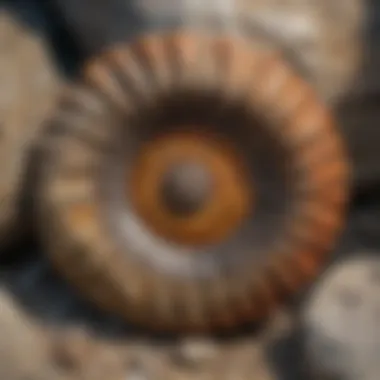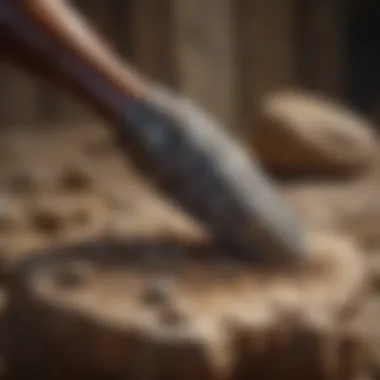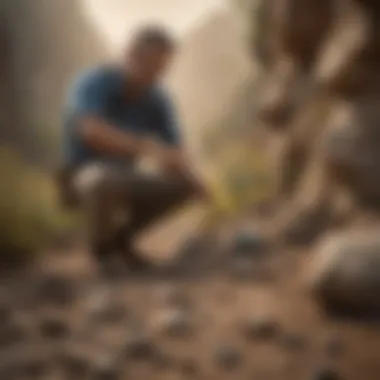Unveiling the Intricacies of Rock Breaking: A Comprehensive Guide for Fossil Collectors


Rock and Fossil Identification
When delving into the captivating world of rock and fossil collecting, a crucial aspect is the identification of rocks and fossils. Various types of rocks and fossils exist, each with distinct characteristics that enthusiasts should be familiar with. By understanding the specific features to look for, collectors can better discern unique specimens from common rocks. Utilizing specialized tools for identification, such as magnifying glasses, UV lights, and hardness testing kits, enhances the precision of classification and adds an intriguing layer to the collecting experience.
Collecting Tips and Techniques
For rock and fossil collectors seeking to elevate their expertise, adopting best practices for collecting is essential. Knowing how to locate prime collecting sites is a skill that can significantly enhance the likelihood of finding extraordinary specimens. Techniques for safely extracting specimens from rock formations without causing damage require careful attention to detail and precision tools like chisels, brushes, and dental picks. Following proper collection etiquette ensures the preservation of delicate specimens and contributes to the sustainability of rock and fossil sites.
Preservation and Display
After the exhilarating discovery of rocks and fossils, enthusiasts must delve into the art of preservation and display. Techniques for preserving specimens, such as using consolidants and protective coatings, are paramount in maintaining their integrity and preventing deterioration over time. Proper storage methods, including acid-free boxes, padded trays, and silica gel packets, help safeguard fragile items. To showcase prized specimens creatively, collectors can explore unique display ideas like shadow boxes, museum-quality stands, and custom labeling to enhance the aesthetic appeal of their collections.
Geological Insights
Exploring the geological insights derived from rocks and fossils adds a profound dimension to the collecting experience. By studying geological formations and processes, enthusiasts gain a deeper appreciation for the Earth's history and the forces that shaped it. Discovering the historical significance of rocks and fossils unveils stories of ancient ecosystems, evolutionary processes, and climatic changes. Examining notable discoveries in the field, such as rare dinosaur fossils or mineral formations, offers a glimpse into groundbreaking contributions to science and the constant evolution of our understanding of the natural world.
Introduction
Understanding the Art of Breaking Rocks
Understanding the art of breaking rocks is a fundamental aspect of rock and fossil collection. It involves more than just physical force; it requires a delicate balance of precision and patience. By grasping the geological composition of rocks and fossils, collectors can enhance their ability to extract specimens without causing damage. This section delves into the intricacies of discerning the right approach to breaking rocks, highlighting the importance of skill and finesse in uncovering hidden treasures.
Overview of Rock and Fossil Collection
The overview of rock and fossil collection serves as the backbone for enthusiasts seeking to expand their knowledge in this field. By understanding the different types of rocks and fossils available for collection, individuals can fine-tune their focus and hone their expertise. This section provides a comprehensive look into the diversity of specimens that can be discovered through rock breaking, emphasizing the significance of a well-rounded collection for both personal enjoyment and scientific study.
Significance of Proper Rock Breaking Techniques


Proper rock breaking techniques are critical in preserving the integrity of specimens and ensuring a successful collection process. By employing the right tools and methods, collectors can minimize the risk of damaging valuable fossils and rocks. This section explores the various techniques that can be utilized, from manual splitting to using advanced equipment for precision extraction. By emphasizing the importance of proper technique, collectors can enhance their efficiency and effectiveness in uncovering and preserving rare geological wonders.
Tools and Equipment
When it comes to the meticulous art of breaking rocks for collecting fossils and geological treasures, having the right tools and equipment is paramount. The tools and equipment section of this comprehensive guide delves into the essential implements necessary for successful rock and fossil collection expeditions. By understanding the specific elements, benefits, and considerations of tools and equipment, enthusiasts can elevate their exploration and discovery experiences.
Essential Tools for Rock Breaking
Rock Hammers
Rock hammers play a pivotal role in the rock-breaking process due to their robust design and efficiency in breaking apart solid formations. The key characteristic of rock hammers lies in their durable pointed or chisel-like head, allowing for precise strikes to split rocks effortlessly. This tool is a popular choice for collectors as it offers excellent leverage and power, making it highly beneficial for breaking rocks and fossil extraction. However, while rock hammers are effective in most scenarios, they can be challenging to use in confined spaces or on extremely hard rocks.
Chisels
Chisels are indispensable tools for detailed work during rock breaking, offering precision and control in shaping and splitting rocks. The key characteristic of chisels is their sharp, narrow edge, which allows collectors to chip away at rocks with accuracy. This tool is popular for its versatility and ability to create fine breakpoints in rocks for targeted extraction. However, chisels require a steady hand and proper technique to avoid damaging delicate specimens.
Safety Goggles
Safety goggles are crucial protective gear essential for rock and fossil collectors to safeguard their eyes during the breaking process. The key characteristic of safety goggles is their impact-resistant lenses and secure fit, providing enhanced safety against flying rock fragments. This equipment is a popular choice for its significant contribution to collector safety by preventing potential eye injuries. However, safety goggles may sometimes fog up, limiting visibility and requiring regular maintenance for optimal use.
Advanced Equipment for Fossil Extraction
Exploring advanced equipment for fossil extraction enhances the efficiency and precision of collecting delicate specimens without causing damage.
Air Scribes
Air scribes are specialized tools that use compressed air to delicately remove surrounding rock matrix from fragile fossils. The key characteristic of air scribes is their pneumatic-powered precision, ensuring controlled and accurate extraction without compromising the specimen's integrity. This equipment is a sought-after choice for professionals and enthusiasts alike due to its ability to uncover detailed fossils with minimal risk of breakage. However, air scribes require a certain level of proficiency to operate effectively and may be expensive for occasional collectors.
Micro Jacks


Micro jacks are compact mechanical devices designed for lifting and separating fragile fossil specimens from surrounding rocks. The key characteristic of micro jacks is their adjustable lifting mechanism, allowing collectors to apply gradual pressure for precise extraction without causing damage. This equipment is favored for its versatility in handling delicate fossils and intricate formations, making it an ideal choice for meticulous extraction processes. However, micro jacks may have limitations in lifting heavier or larger specimens, requiring additional support for complex extractions.
Preparation Tools
Preparation tools encompass a range of instruments such as brushes, needles, and adhesive materials essential for cleaning and preserving fossil specimens post-extraction. The key characteristic of preparation tools is their meticulous detail-focused design, enabling collectors to refine and showcase their discoveries with fine precision. These tools are invaluable for maintaining specimen integrity and preparing them for display or further study. However, preparation tools demand careful handling and storage to prevent damage or contamination of fragile fossils and geological finds.
Techniques and Methods
Breaking rocks for collecting fossils and geological treasures requires a delicate balance of precision and skill. In this section, we will explore the crucial role of techniques and methods in maximizing the success of rock breaking endeavors. By employing the right strategies and approaches, collectors can enhance their efficiency and increase the likelihood of uncovering rare specimens. Understanding the various techniques available and knowing when to utilize them is key to a productive and rewarding rock breaking experience.
Manual Splitting and Cracking
Manual splitting and cracking represent fundamental techniques in the realm of rock breaking. By using basic tools such as rock hammers and chisels, collectors can carefully break apart rocks to reveal hidden treasures within. This technique allows for a hands-on approach, giving collectors a sense of control and intimacy with the specimens they uncover. Manual splitting and cracking require patience and precision, as one wrong move can damage valuable fossils or minerals embedded within the rock.
Using Mechanical Tools for Precision
In contrast to manual techniques, utilizing mechanical tools for precision offers a more efficient and targeted approach to rock breaking. Air scribes, micro jacks, and advanced preparation tools provide collectors with enhanced accuracy and control when extracting fossils from rocks. These tools allow for delicate extraction processes, minimizing the risk of breakage and preserving specimen integrity. While mechanical tools require a certain level of expertise to operate effectively, they can greatly expedite the process of rock breaking and increase the likelihood of successful finds.
Safety Precautions During Rock Breaking
Safety should always be paramount when engaging in rock breaking activities to ensure both personal well-being and the protection of valuable specimens. Wearing protective gear is essential to shield against flying debris and potential hazards present during rock breaking. Avoiding overexertion is crucial to prevent fatigue and ensure optimal judgment and physical ability while handling tools and rocks. Securing the work area is vital to maintain a safe and organized environment, reducing the risk of accidents and facilitating a smooth operation throughout the rock breaking process.
Exploring Geological Formations
In the realm of rock and fossil collection, the process of exploring geological formations holds immense significance. It serves as the bedrock, pun intended, for the entire endeavor of discovering and procuring unique specimens. Understanding the geological landscape is crucial as it dictates where potential treasures may lie hidden. By delving into the geological formations, collectors can decipher the history embedded in the rocks, unveiling ancient stories preserved over millennia.
Exploring geological formations provides collectors with a roadmap to navigate the expansive world of rocks and fossils. By studying the composition, structure, and layers of the earth's surface, enthusiasts can pinpoint areas rich in geological diversity. This knowledge acts as a compass, guiding collectors towards regions likely to yield valuable finds. Additionally, exploring these formations fosters a deeper connection to the natural world, igniting a sense of wonder and curiosity about the Earth's past.
The benefits of delving into geological formations go beyond mere collection; it promotes a deeper appreciation for the geological processes that have shaped our planet. By examining rocks in their natural context, collectors gain insight into the forces that have sculpted the Earth over millions of years. This firsthand experience allows individuals to witness the intricate beauty of geological formations up close, fostering a sense of awe and reverence for the Earth's ancient history.


When exploring geological formations, collectors must consider various factors such as geological diversity, accessibility, and preservation. Different regions offer unique geological features, each holding its own geological treasures waiting to be uncovered. By strategizing and identifying areas of interest, collectors can optimize their exploration efforts, increasing the likelihood of making significant discoveries. Additionally, understanding the geological history of an area is essential for preserving its integrity and ensuring that future generations can also appreciate its natural wonders.
In essence, exploring geological formations is not just about finding rocks and fossils; it is a journey into the Earth's past, a voyage of discovery that unveils the wonders of our planet's geological heritage. By immersing oneself in the geological tapestry of our planet, collectors can uncover hidden gems and unravel the mysteries locked within the rocks, forging a deeper connection to the ancient forces that have shaped our world.
Preservation and Display
In the world of rock and fossil collecting, Preservation and Display play a crucial role in showcasing and safeguarding valuable specimens. Proper preservation techniques ensure the longevity of fossils and rocks, preserving their scientific and aesthetic value for future generations. Displaying these treasures not only adds an aesthetic element to your collection but also allows you to share your discoveries with others, sparking interest and appreciation for the natural world.
Cleaning and Preserving Fossils
When it comes to Cleaning and Preserving Fossils, meticulous care is essential to retain the integrity of these delicate specimens. Cleaning fossils requires gentle techniques to remove dirt and sediment without causing damage. Preservation methods involve stabilizing fossils to prevent deterioration, which can involve using consolidants to strengthen fragile structures. Each fossil type may require specific cleaning and preservation approaches, emphasizing the importance of research and caution in handling these priceless artifacts.
Showcasing Your Collection
Showcasing Your Collection is an art form in itself, allowing collectors to curate their displays to highlight the uniqueness of each specimen. Considerations such as lighting, arrangement, and labeling play a vital role in presenting fossils and rocks in an engaging and informative manner. Choosing the right display methods not only enhances the visual appeal of your collection but also educates viewers about the geological significance of each item, fostering a deeper appreciation for the Earth's history.
Maintaining Specimen Integrity
Maintaining Specimen Integrity is a top priority for collectors committed to preserving the authenticity of their treasures. This involves regular inspection and care to prevent physical damage, dust accumulation, or exposure to harmful environmental factors. Proper storage, such as sturdy display cases or specialized containers, safeguards specimens from accidental harm and ensures their longevity. By prioritizing specimen integrity, collectors uphold the scientific value and aesthetic beauty of their rocks and fossils, enriching their collection for years to come.
Conclusion
In the realm of rock and fossil collecting, the conclusion serves as a pivotal moment encapsulating the essence of the meticulous journey of breaking rocks. As enthusiasts navigate through the nuances of this art form, the conclusion acts as a harmonious culmination, underscoring the significance of each step taken. It not only reflects on the tangible outcomes but also delves into the intangible rewards of perseverance and passion embedded in this pursuit. By revisiting the initial intrigue that sparked the desire to explore geological formations and unveil hidden treasures, the conclusion imparts a sense of fulfillment and achievement.
Explicitly, the conclusion in this article fosters a deep appreciation for the art of breaking rocks by emphasizing the transformative power of curiosity and dedication. It reinforces the notion that beyond the physical specimens extracted lies a profound connection to the Earth's history and evolutionary narrative. Moreover, the conclusion serves as a call to action for collectors to reflect on their experiences, cherish their discoveries, and perhaps inspire others to embark on similar quests for geological marvels.
In essence, the conclusion is not merely a summary but a poignant reflection on the joys and challenges inherent in the art of breaking rocks. It resonates with the core ethos of exploration and enlightenment, urging enthusiasts to continue their pursuit with renewed vigor and admiration for the natural world.
Appreciating the Art of Rock Breaking
Central to the fabric of rock and fossil collection is the intrinsic artistry hidden within the act of breaking rocks. Appreciating the art of rock breaking involves more than just physical exertion; it requires a deep understanding of geological formations, patience, and a keen eye for detail. Enthusiasts are drawn to this art form not only for the thrill of discovery but also for the intellectual stimulation it offers.
At the heart of appreciating the art of rock breaking lies a profound respect for the Earth's history and the delicate process of uncovering hidden treasures. It is a dance between science and intuition, where collectors decode the language of rocks to reveal their secrets. The satisfaction derived from carefully splitting a rock to expose a well-preserved fossil or a gleaming mineral transcends mere excitement; it symbolizes a symbiotic relationship with the Earth's ancient past.
Furthermore, appreciating the art of rock breaking necessitates a commitment to preservation and conservation. Collectors understand the delicate balance between extracting specimens for study and ensuring that geological wonders are safeguarded for future generations. This ethical consideration underscores the reverence and responsibility inherent in the practice of rock breaking.







